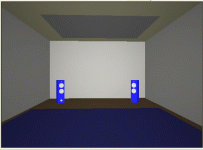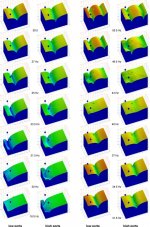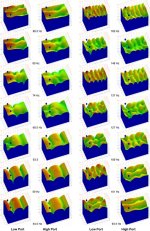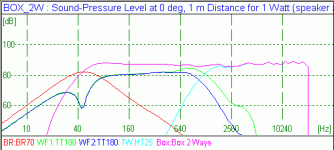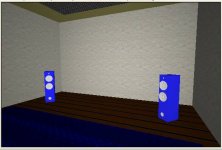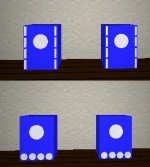No worries Mark. I'm always fascinated about the theory and continuously learning. I'm actually chuffed to bits with the Onken bass (using lambswool)... do feel free to pop down...
I'm still busy messing around with my Behringer... such a great toy but I think I'll need a better mic... fun and games... fun and games...
JJ
I'm still busy messing around with my Behringer... such a great toy but I think I'll need a better mic... fun and games... fun and games...
JJ
IslandPink, yes, the Supravox/Jensen pix are exactly what I was thinking of. The choice of damping material makes a big, big difference to the sound. In the "Beyond the Ariel" thread, I was surprised to see recommendations for pearlite (available at garden-supply stores) and activated charcoal (dunno where you get that). I think feather pillows are worth exploring as well.
It may sound like wacko speculation, but I suspect some of the bass-reflex sound is due to the small point-source vents having a suboptimal coupling to the room. I tried the Ariel with a rear vent halfway up the enclosure and there was no bass at all - well, not really, but it was thin and uneven-sounding. The speaker was also very fiddly about room locations, too. Moving the vent to the floor made a big difference in subjective and measured smoothness of the bass. I really think the distributed vents of the Onken are a big part of the bass quality.
It may sound like wacko speculation, but I suspect some of the bass-reflex sound is due to the small point-source vents having a suboptimal coupling to the room. I tried the Ariel with a rear vent halfway up the enclosure and there was no bass at all - well, not really, but it was thin and uneven-sounding. The speaker was also very fiddly about room locations, too. Moving the vent to the floor made a big difference in subjective and measured smoothness of the bass. I really think the distributed vents of the Onken are a big part of the bass quality.
Lynn Olson said:Vent locations matter, although this doesn't show up in the simulations.
I thought this worth pursuing, to see if my CARA software would simulate a different vent position (it should).
And it does! See image below for an idea of the room and speakers. You will see the dual woofer floor-standers. The left speaker has the vent near the bottom on the front, the right has the vent on the back near the top (you can't see it).
In simulations of the room, there is a noticable difference at many frequencies. I can post captures of the sims, if anyone cares to see them.
So maybe this distributed port thing is what is going on. Very interesting.......
Attachments
I'd like to see it. Port locations matter more than people think, especially considering the narrow spectral output of the ports in most vented-speaker alignments. You have a one-octave emitter driving the room with what amounts to a point source (relative to the wavelengths involved).
jonjin,
Nice project.
I also have ah425 and gpa CD.
I think that horn sounds really good but I am newbie and give them to mr.Lampizator, to check it.
http://www.lampizator.eu/
(He live 180km from me)
Best
C
Nice project.
I also have ah425 and gpa CD.
I think that horn sounds really good but I am newbie and give them to mr.Lampizator, to check it.
http://www.lampizator.eu/
(He live 180km from me)
Best
C
I did the port position simulations - that ws the easy part. Getting them into a format that was meaningful and web friendly was not!
So I settled for 2 strips of graphs that show the SPL at 28 different frequencies from 18 to 160 Hz. The 2 different port postions are shown side by side. The speakers with the port on the bottom is shown on the left - speaker with the port on the top rear is shown on right.
The speakers were placed in what the CARA software found to be the best postion in this room given the restrictions of eqaul distance from back and side walls and pointing at the listener. Both sims (hi & lo ports) have the speakers in the same place.
Here is strip 1.
edit: The speakers are under the blue pins. Listener under the yellow pin.
(you can see both together and larger here🙂
http://www.dactransformations.com/ports/
So I settled for 2 strips of graphs that show the SPL at 28 different frequencies from 18 to 160 Hz. The 2 different port postions are shown side by side. The speakers with the port on the bottom is shown on the left - speaker with the port on the top rear is shown on right.
The speakers were placed in what the CARA software found to be the best postion in this room given the restrictions of eqaul distance from back and side walls and pointing at the listener. Both sims (hi & lo ports) have the speakers in the same place.
Here is strip 1.
edit: The speakers are under the blue pins. Listener under the yellow pin.
(you can see both together and larger here🙂
http://www.dactransformations.com/ports/
Attachments
and the second half of the series is below.
These look like wasves in the roon, but they are not. It's just a 3D view of sound levels at a given frequency. It could be done in 2D, but the 3D is more dramatic.
You can see the the bass levels are higher at a number of frequencies with the low ports (more red).
Other than that, draw your own conclusions.
(you can see both together and larger here)
http://www.dactransformations.com/ports/
These look like wasves in the roon, but they are not. It's just a 3D view of sound levels at a given frequency. It could be done in 2D, but the 3D is more dramatic.
You can see the the bass levels are higher at a number of frequencies with the low ports (more red).
Other than that, draw your own conclusions.
(you can see both together and larger here)
http://www.dactransformations.com/ports/
Attachments
And finally this is the end of the room with the speakers.
Shown are the low port version. Speakers are 80cm tall.
High port version is the same, but port is in on the back behind the tweeter.
Next step is to build a simulated Onken box and compare it to a normal BR box of the same size and shape.
Hope you enjoy the pretty pictures.
Shown are the low port version. Speakers are 80cm tall.
High port version is the same, but port is in on the back behind the tweeter.
Next step is to build a simulated Onken box and compare it to a normal BR box of the same size and shape.
Hope you enjoy the pretty pictures.
Attachments
Hi IP,
The calcs are done in 3D throughout the whole room, but shown for a 1 meter hight - ear level. Aprox. 1000 points at calculated across the room at ear hight. All that can be changed in the software - those are just the defautls.
I did build a model of the "Petit Onken" for the 12" Altec.
And a version with 6 rounds vents across the bottom - same surface area as the Onken slots. The in room response does look smoother for the veritcal Onken slots, but the difference isn't huge. I'll try to get the results in a usable format and post them.
The calcs are done in 3D throughout the whole room, but shown for a 1 meter hight - ear level. Aprox. 1000 points at calculated across the room at ear hight. All that can be changed in the software - those are just the defautls.
I did build a model of the "Petit Onken" for the 12" Altec.
And a version with 6 rounds vents across the bottom - same surface area as the Onken slots. The in room response does look smoother for the veritcal Onken slots, but the difference isn't huge. I'll try to get the results in a usable format and post them.
Attachments
Interesting, indeed....
There was/is another Onken thread a while back, where some of us were fiddling with the Onken calculator. One question that came up, was which drivers were suitable for the "Onken alignment", except for the orogonal Altecs. Somehow it was not possible to reverse the spreadsheet to find a suitable range of TS parameters for alternative drivers.
But if the assumption of Onkens really being large port BRs, then in theory any good driver suitable for normal BR duty should be OK, - just enlarge the port area and calculate to a suitable response alignment?
There was/is another Onken thread a while back, where some of us were fiddling with the Onken calculator. One question that came up, was which drivers were suitable for the "Onken alignment", except for the orogonal Altecs. Somehow it was not possible to reverse the spreadsheet to find a suitable range of TS parameters for alternative drivers.
But if the assumption of Onkens really being large port BRs, then in theory any good driver suitable for normal BR duty should be OK, - just enlarge the port area and calculate to a suitable response alignment?
I've just read again some of the magazine l'Audiophile. Alignments found by J. Mahul are :
- 6.34 for small Onken (Altec 414)
- 7.35 for regular Onken (Altec 416).
When the 416 driver was no longer available Focal released its first incarnation of the Audiom 15. Supposedly a super 416, designed for a Onken cabinet with small Onken size and regular Onken performance. J. Mahul published an article describing this cabinet which featured 4 slots on each side, 2 horizontal slots at the top and 2 more at the bottom. Alignment was 7.4. One of the criticism addressed to this design was relative to the bloated sound around 100 Hz due to the bottom slots interaction with the floor. Things got a little bit better by blocking these.
- 6.34 for small Onken (Altec 414)
- 7.35 for regular Onken (Altec 416).
When the 416 driver was no longer available Focal released its first incarnation of the Audiom 15. Supposedly a super 416, designed for a Onken cabinet with small Onken size and regular Onken performance. J. Mahul published an article describing this cabinet which featured 4 slots on each side, 2 horizontal slots at the top and 2 more at the bottom. Alignment was 7.4. One of the criticism addressed to this design was relative to the bloated sound around 100 Hz due to the bottom slots interaction with the floor. Things got a little bit better by blocking these.
IslandPink said:Can someone please explain how the numeric value of the alignment is specified ?
You mean n ?
That's n in T&S formula : Vbox = n * Vas * Qts^2
5.7 is maximally flat freq. response, greater it's underdamped, smaller it's overdamped.
Thanks Gairsun . I will write that down !
Hey, Panomaniac, those plots are very interesting . I went to your link , where the plots are a bit bigger and easier to read .
There are small differences generally, but around 100Hz the differences are quite large . Generally the levels are a bit higher for the lower port, but the nulls are stronger too.
I suppose one low port at front and one high port at rear is as big a difference as you could get, I expect front ports low or high would be slightly more similar . However, having a combination of placements ought to help smooth bass resonse in the room a bit - must be of some benefit .
I think it's interesting that the current big Tannoy cabinets have very long slot ports , so maybe the Onken principal has some merits even in the era of computer-aided design ?
MJ
Hey, Panomaniac, those plots are very interesting . I went to your link , where the plots are a bit bigger and easier to read .
There are small differences generally, but around 100Hz the differences are quite large . Generally the levels are a bit higher for the lower port, but the nulls are stronger too.
I suppose one low port at front and one high port at rear is as big a difference as you could get, I expect front ports low or high would be slightly more similar . However, having a combination of placements ought to help smooth bass resonse in the room a bit - must be of some benefit .
I think it's interesting that the current big Tannoy cabinets have very long slot ports , so maybe the Onken principal has some merits even in the era of computer-aided design ?
MJ
Hi IP -
Yes, I did change the placement of the port as much as possible to see the difference. Kinda makes me wonder is a low port an high port might not even things out?
As for the Onken, below you will see a sim of the Petit Onken in the same room as the previious sims. This time just 4 frequency slices. There is hardy any difference at all between the vetical slot array of the Onken and the same surface area with round vents at the bottom face.
Yes, there is a but more bass from the botton only ports, but not the dramatic differecne seen in the last sim. Speakers are placed at the blue dots - firing straight into the room.
Caveats: It's only a simulation. SPL is shown at 1M hight in the room - ear level. SPL is calculated from reflections and absorbtion throught the whole room.
Frequency slices may not be fine enough. E.G. there may be a peak we're not seeing between my slices. Have not yet found a way to go to finer frequency slices.
Giarsun - Meci pour la formule!
Yes, I did change the placement of the port as much as possible to see the difference. Kinda makes me wonder is a low port an high port might not even things out?
As for the Onken, below you will see a sim of the Petit Onken in the same room as the previious sims. This time just 4 frequency slices. There is hardy any difference at all between the vetical slot array of the Onken and the same surface area with round vents at the bottom face.
Yes, there is a but more bass from the botton only ports, but not the dramatic differecne seen in the last sim. Speakers are placed at the blue dots - firing straight into the room.
Caveats: It's only a simulation. SPL is shown at 1M hight in the room - ear level. SPL is calculated from reflections and absorbtion throught the whole room.
Frequency slices may not be fine enough. E.G. there may be a peak we're not seeing between my slices. Have not yet found a way to go to finer frequency slices.
Giarsun - Meci pour la formule!
Attachments
- Status
- Not open for further replies.
- Home
- Loudspeakers
- Multi-Way
- Reviving the Onken
